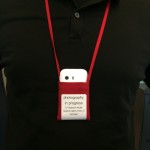A number of wearable ‘lifelogging’ camera devices have been released recently, allowing consumers to capture images and other sensor data continuously from a first-person perspective. While lifelogging cameras are growing in popularity, little is known about privacy perceptions of these devices or what kinds of privacy challenges they are likely to create. To explore how people manage privacy in the context of lifelogging cameras, as well as which kinds of first-person images people consider ‘sensitive,’ we conducted an in situ user study (N = 36) in which participants wore a lifelogging device for a week. Our findings indicate that: 1) some people may prefer to manage privacy through in situ physical control of image collection in order to avoid later burdensome review of all collected images; 2) a combination of factors including time, location, and the objects and people appearing in the photo determines its ‘sensitivity;’ and 3) people are concerned about the privacy of bystanders, despite reporting almost no opposition or concerns expressed by bystanders over the course of the study. Read our paper or visit our project page.
Our Work on Privacy Behaviors of Lifeloggers to Appear at UbiComp 2014


